This information has been commissioned by the Goulburn Murray Valley (GMV) Fruit Fly Program and is funded by the Victorian Government. Use of this material in its complete and original format, acknowledging its source, is permitted, however unauthorised alterations to the text or content is not permitted.
Current trends in Queensland fruit fly populations and the outlook for February 2022
- Trapping data for Cobram (rural and urban) is not included in this report due to the fact that, as a result of the Sterile Insect Technique Pilot Trial being carried out in Cobram, sterile Queensland fruit fly have not been separated from wild fruit fly since mid-December. When this data is known it will be reported.
- Trapping data reveals that the usual spring peak in fruit fly numbers did not occur during spring 2021 as it has during spring in previous years. If there was a peak in some urban locations, it was delayed with the peak occurring in November rather than September.
- At present 64% of the Goulburn Murray Valley’s Queensland fruit fly population is located in urban sites.
- Currently, weather conditions are suitable for fruit fly to mate and lay eggs although hot, dry weather, in some areas, will reduce the numbers of fruit available for fruit fly to sting. The heat will kill eggs and larvae in fruit that is exposed to the sun.
- Eggs laid during January, if they survive the Goulburn Murray Valley’s usual heat and lack of moisture, will become a new generation of pest fruit flies in late summer and autumn which will attack your autumn crop of fruit and fruiting vegetables. Ripe or ripening fruit under irrigation are particularly susceptible to fruit fly stinging fruit.
- These flies may spread from urban areas, through peri-urban sites and into commercial crops during this time.
- Action now will cut the next fruit fly generation and increase future home garden productivity
- Fruit and tree removal and destruction, fruit fly baits, netting, and monitoring ripening fruit for sting marks or with traps in home gardens, untended areas, council and Crown land, roadsides, riverbanks, business sites, etc.
- Action for commercial orchardists include:
- Ensure fresh (or within use-by date) traps are deployed and are being checked as often as possible – certainly once a week.
- Check ripe and ripening fruit for fruit fly sting marks – preferably daily.
- If Queensland fruit fly is a constant problem ensure supplies of fruit fly control material such as baits and approved pesticides are in storage and within their use-by dates.
Regional trapping grid – general trends and activity
A total of 2,353 Queensland fly were trapped from about 295 traps so far this fruit fly season (starting from early July 2021) [Figure 1]. This is lower than for the same period last year which recorded 3,889 Queensland fruit fly.
This year the general trend in fruit fly numbers is following the usual trend (see Figure 2). Queensland fly numbers being trapped are now on the rise in peri-urban and rural areas but are declining in urban areas.
Last year’s fruit fly season was a heavy year for Queensland fruit fly. This was most likely due to a combination of benign weather conditions during the previous autumn, winter and spring (i.e. a La Nińa event) plus a large volume of unharvested host crop due to COVID restrictions. It is believed that the combination of the GMV’s area-wide management program and periodic weather conditions impacted adversely on fruit fly survival this season.
The graph below (Figure 1) shows that there has been a decline in numbers of Queensland fruit fly fly trapped during the late spring and early summer this year compared with last year.
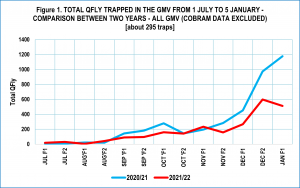
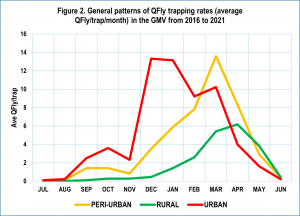
Impact of land use type
Rural traps caught 416 Queensland fruit fly (18%) during this period while the majority (1,513; 64%) were trapped in urban locations. Peri-urban traps caught 18% of fruit fly in the Goulburn Murray Valley during this period. [Table 1]. Numbers of fruit fly trapped were much lower this year than last year for both peri-urban and urban locations (more than 50% reduction). Queensland fruit fly trapped in rural locations was almost as high this year as last year.

Outlook for home gardeners in the Goulburn Murray Valley
Typically, at this time of year fruiting plants are finishing off in urban areas of the Goulburn Murray Valley as fruit is harvested, eaten by birds or deteriorate and fall off due to hot, dry weather. As a result, populations generally decline during January and February in urban areas of the region.
The Bureau of Meteorology forecasts similar rainfall (i.e. low) and minimum temperatures to the average but maximum temperatures are likely to be lower than average. These weather patterns favour the survival of both fruit on tree/vine/bush and fruit fly.
All of the above observations change when garden irrigation is used in urban areas. Irrigation provides ideal conditions for fruit fly maturation, survival and proliferation. Queensland fruit fly populations can explode and then, when crops in urban locations are diminished fruit fly will move out of urban areas, into and through peri-urban places and into commercial orchards. This migration is facilitated by high volumes of fruit in commercial orchards ripening from February through May.
If urban growers can deal with fruit fly in their gardens using the usual area-wide management strategies described in the above, they will achieve good production in their own garden and also assist commercial growers by cutting off the urban-to-rural migration.
Outlook for commercial horticultural production in the Goulburn Murray Valley
Queensland fruit fly start to build up in peri-urban and rural locations of the Goulburn Murray Valley during February. Many fruit fly move out of urban areas and into rural locations due to lack of resources, irrigation in rural areas and mass-ripening of fresh fruit. However, some fruit fly may have overwintered in rural locations within evergreen canopies often in sites close to houses and other heated out-buildings. These flies will start moving out of hibernation and start looking for mates and fresh ripening fruit to infest.
It is essential for commercial growers to ensure there are no unwanted fruiting plants within about 1km of their orchard, roadside feral fruits (e.g. peaches), plants along creek banks, on Crown land, abandoned orchards and very importantly, the house yards of your orchard and the neighbours. These fruit are the staging points for a rapid increase in fruit fly populations that would then threaten crops.
Commercial orchards situated within 1km of hot spot locations mentioned below are especially at risk from fruit fly. Vigilance with traps and by fruit checking is essential here.
Queensland fruit fly hot spots
Throughout the Goulburn Murray Valley and its nearly 400 traps (including Cobram’s) there is a general trend of a lower Queensland fruit fly count this season compared with last season. However, there are a few locations that heavily bias total numbers. These are the so-called ‘hot spots’. Hot spots can be habitual, where they occur each year at approximately the same time or they can be new hot spots where fruit fly have moved into a new area, settle there and proliferate.
Active area-wide management work, such as netting and host plant removal (in urban areas), baiting (in commercial production areas), trap monitoring and fruit checking (in all areas of the Goulburn Murray Valley) will over time, erase these hot spots. There have been some successes in hot spot deletion in the region since the project commenced.
At present most Qfly hot spots are located in urban areas.
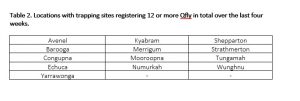
The abovementioned sites are of concern as they could become sites from which large numbers of Qfly could establish and then spread, so it is important that members of the GMV community who have gardens and orchards in these areas take precautions to reduce the ability of Qfly to infest fruit and to survive in them.
Be on the look-out for exotic pest fruit flies
The Goulburn Murray Valley Regional Fruit Fly office is asking the community to be on the lookout for a range of exotic pest fruit fly species that would seriously impact horticultural production, in both home gardens and commercial orchards in the region. The ‘top five’ for the Goulburn Murray Valley as listed below.
Also refer to Agriculture Victoria’s Victoria’s Fruit Fly Strategy 2021-2025 https://agriculture.vic.gov.au/biosecurity/protecting-victoria/victorias-fruit-fly-strategy-2021-to-2025).
- Queensland fruit fly [Qfly] (Bactrocera tryoni) – this pest infests most fruit and fruiting vegetables grown in Victoria and has become established in many parts of Victoria, including the GMV. Community members are encouraged to use area-wide management methods for reducing the impact of this pest – monitoring with traps and by fruit checking; removal of unwanted host crops including feral, garden and abandoned plants; picking fruit at the green stage; netting, baiting, approved pesticides.
- Mediterranean fruit fly [Medfly] (Ceratitis capitata) – this pest also attacks most fruit and fruiting vegetables but is NOT PRESENT IN VICTORIA. However, it has established population in several regions of Western Australia and there are periodic outbreaks in South Australia each year, recently. This means that Victoria is at high risk. More information at: https://agriculture.vic.gov.au/biosecurity/pest-insects-and-mites/priority-pest-insects-and-mites/mediterranean-fruit-fly
- Spotted wing drosophila (Drosophila suzukii) – NOT PRESENT IN AUSTRALIA. This pest has recently left its homelands in north east Asia and spread to many parts of the world. It attacks all berries (including grapes) and most pome and stone fruit. If it got into Australia via illegal or untreated imports it would impact seriously on GMV horticultural production and exports. See: https://www.planthealthaustralia.com.au/pests/spotted-winged-drosophila/
- Oriental fruit fly (Bactrocera dorsalis) – NOT PRESENT IN AUSTRALIA. This pest has also spread into many regions around the world recently invading Italy and France. It attacks more fruits and vegetables than Qfly and Medfly and is a major impact pest. For a general discussion on exotic pest fruit flies see: https://www.awe.gov.au/biosecurity-trade/pests-diseases-weeds/plant/fruit-flies
- Olive fly (Bactrocera oleae) – NOT PRESENT IN AUSTRALIA. The olive fly is the number one pest in olives grown around the Mediterranean. It has invaded and established in the USA and is highly invasive. The GMV’s olive industry would be at very high risk of olive fly invading via illegal and untreated imports. See: https://olivebiz.com.au/wp-content/uploads/2020/08/Field-Guide-2nd-edn-revised.pdf
Weather outlook and its impact on fruit fly
Over the next few weeks, the numbers of Queensland fruit fly trapped in the Goulburn Murray Valley, if they follow normal trends, will rise. This will be the commencement of the peak fruit fly season for 2021/22 which will then spread, if left untouched, from urban areas to commercial orchards in the local district.
Weather forecasts for February 2022 were accessed from the Bureau of Meteorology. Data indicates that:
- There is a 50% to 60% chance that rainfall over the region will exceed the average (which is predominantly 10-25mm for February based on the past 10 years).
- There is only a 25% chance that maximum temperatures will be higher than the average of 30-33°C. The Bureau of Meteorology forecasts an average cooling of maximum temperatures in the Goulburn Murray Valley for February by 1°C to 3°C.
- There is a 50% chance that minimum temperatures will be above the average of 15°C to 18°C. Average minimum temperatures or possibly 1°C cooler than average are likely for the Goulburn Murray Valley during February.
Usual January/ February weather patterns are hot and dry. The Bureau of Meteorology forecasts suggests that February conditions may be milder than normal with regards to temperatures. Although the forecast temperatures are optimal for fruit fly survival and development rainfall is a limiting factor. Even if there is more rain than average it is still lower than optimal for fruit fly. However, in home gardens where weather conditions are modified by irrigation, and the presence of evergreen plants for refuge and early fruits and vegetables for egg-laying, Queensland fruit fly will thrive if not managed correctly. During this period of the year many fruit fly will likely migrate from home gardens, through peri-urban orchards and gardens and into outlying rural commercial orchards and gardens.
Figure 3. Chance of exceeding median rainfall in February 2022
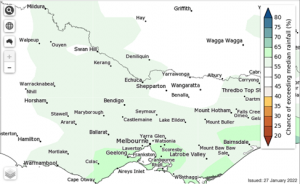
Figure 4. Maximum temperatures: likely differences from the average for February 2022
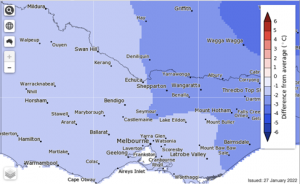
Figure 5: Minimum temperatures: likely differences from the average for February 2022
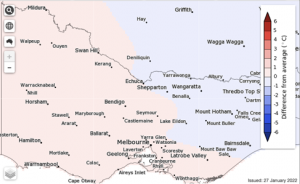
Goulburn Murray Valley Fruit Fly Program
For assistance in managing Queensland fruit fly, contact the Project Coordinator at the Goulburn Murray Valley Fruit Fly Office by phoning (03) 5871 9222 or email gmvfruitfly@moira.vic.gov.au.
This report was produced and supplied by Janren Consulting Pty Ltd for the purpose of the Goulburn Murray Valley Fruit Fly Program. The Goulburn Murray Valley Fruit Fly Program is supported by the Victorian Government.
